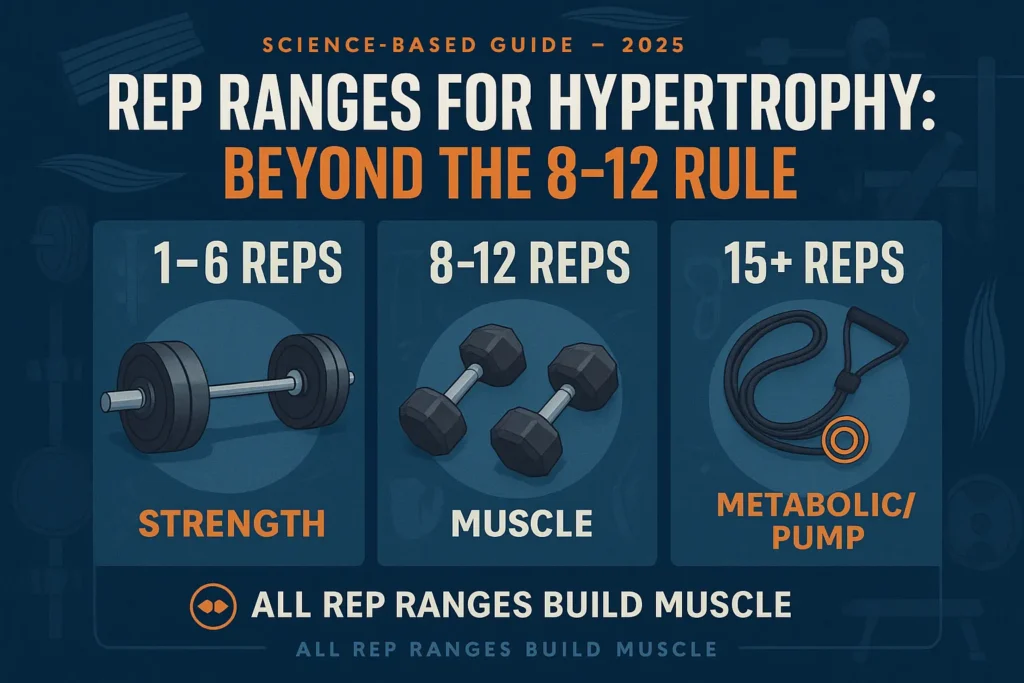
Here’s a shocking fact that might change how you train forever: recent research shows that you can build just as much muscle doing 30 reps as you can doing 8 reps! I know, I know – it sounds crazy, right? For decades, we’ve been told that the magical 8-12 rep range is the holy grail for muscle growth, and anything outside of that is basically useless for hypertrophy.
But here’s the thing – science has evolved, and so should our understanding of how muscle growth actually works. After years of following the traditional rep range dogma and seeing mixed results, I dove deep into the latest research and completely transformed my approach to training. What I discovered will probably surprise you as much as it surprised me.
I’ll never forget the day I decided to throw caution to the wind and try something different. I was stuck in the worst plateau of my lifting career – my arms hadn’t grown in months despite religiously hitting that 8-12 rep sweet spot everyone talks about. Out of pure frustration, I started doing 20-25 rep sets for my bicep curls, thinking I had nothing left to lose.
Three weeks later, my girlfriend asked if I’d been doing something different because my arms looked bigger. That’s when I realized I’d been limiting myself for years!
The truth is, your muscles don’t have a rep counter, and they certainly don’t care if you’re doing 6 reps or 25 reps – they only care about one thing: are you challenging them enough to adapt and grow? Let’s dive into what the science actually tells us about rep ranges and muscle growth.
The Science Behind Muscle Growth and Rep Ranges
Man, I wish someone had explained this stuff to me when I first started lifting. For the longest time, I thought muscle growth was some mysterious process that only happened if you followed very specific rules. Turns out, it’s actually pretty straightforward once you understand the mechanisms.
There are three main pathways that trigger muscle growth: mechanical tension, metabolic stress, and muscle damage. Think of these as three different roads that all lead to the same destination – bigger muscles.
Mechanical tension is basically the force your muscles generate when they contract against resistance. This happens regardless of whether you’re doing heavy singles or light sets of 20. The key is that the tension needs to be high enough to signal your body that it needs to adapt.
I used to think that only heavy weights created enough tension for growth. Boy, was I wrong! Research from 2021 showed that when you take lighter weights to failure, the mechanical tension in those final reps is just as high as when you’re grinding through heavy sets. Your muscles are working just as hard – they’re just doing it for longer.
Metabolic stress is that burning sensation you feel during high-rep sets. You know, that feeling where your muscles are screaming and you can barely complete another rep? That’s not just pain – that’s your muscles creating the perfect environment for growth through the accumulation of metabolites and cellular swelling.
The crazy part is that this metabolic stress pathway was largely ignored for years because everyone was so focused on heavy lifting. But recent studies have shown that this “pump” style training can be incredibly effective for hypertrophy, especially when combined with other training methods.
Muscle damage used to be considered the primary driver of growth, but we now know it’s more of a side effect than a requirement. Some muscle damage can trigger growth responses, but too much actually hinders recovery and progress. This is why those brutal workouts that leave you unable to walk for a week aren’t necessarily better for building muscle.
Low Rep Training (1-6 Reps) for Muscle Growth
Okay, let me tell you about the time I accidentally discovered that heavy singles could actually help me build muscle. I was training for a powerlifting meet and spending most of my time in the 1-5 rep range, focusing purely on strength. I figured I’d probably lose some size during this phase, but I was willing to make that sacrifice.
Three months later, people kept asking if I’d been bulking because I looked noticeably bigger, especially in my upper back and shoulders. What the heck was going on?
Here’s what I learned: low rep training builds muscle differently than traditional hypertrophy work, but it absolutely builds muscle. When you’re handling heavy weights, every single rep requires maximum motor unit recruitment. Your body is forced to activate as many muscle fibers as possible just to move the weight.
The key with low rep training for hypertrophy is volume. You can’t just do three singles and call it a day. I typically do 6-10 sets when I’m working in the 1-5 rep range, which gives me plenty of total volume while keeping the intensity sky-high.
Safety becomes crucial here though. I learned this the hard way when I got a little too aggressive with my deadlift progression and tweaked my lower back. Now I always make sure I’m properly warmed up, my form is dialed in, and I have a spotter when needed.
The best exercises for low rep hypertrophy work are your big compound movements – squats, bench press, deadlifts, overhead press, and rows. These movements allow you to handle the heaviest weights safely while working multiple muscle groups simultaneously.
One thing that surprised me was how much my work capacity improved when I started incorporating heavy doubles and triples. My muscles adapted to handling heavier loads, which meant when I went back to moderate rep work, I could use significantly more weight for my 8-12 rep sets.
The Traditional Hypertrophy Range (8-12 Reps) Explained
Let’s be real – there’s a reason the 8-12 rep range became the gold standard for bodybuilding. It works, and it works really well for a lot of people. This range sits in a sweet spot where you can use moderately heavy weights while still accumulating enough volume to trigger significant muscle growth.
I spent probably my first five years of lifting almost exclusively in this range, and I made solid progress. The loads are heavy enough to create substantial mechanical tension, but not so heavy that you’re limited by your nervous system or risk injury with every rep.
What makes this range so effective is the balance between intensity and volume. You can typically perform multiple sets in this range without completely frying your central nervous system, which means you can train more frequently and accumulate more total weekly volume for each muscle group.
The 8-12 rep range also tends to produce a good muscle pump, which we now know contributes to hypertrophy through the metabolic stress pathway. You get that satisfying feeling of your muscles feeling full and tight after your workout, which isn’t just for show – it’s actually contributing to growth.
I’ve found that this range works particularly well for isolation exercises. Bicep curls, tricep extensions, lateral raises – these movements seem to respond really well to moderate rep ranges. You can focus on the mind-muscle connection and really feel the target muscle working without worrying about complex movement patterns or safety issues.
Programming in this range is pretty straightforward too. Most people can handle 3-4 sets per exercise, and you can train most muscle groups 2-3 times per week without running into recovery issues. It’s a forgiving rep range that allows for consistent progression over time.
High Rep Training (15+ Reps) for Serious Muscle Growth
This is where things get interesting, and honestly, where most people’s comfort zones go to die. High rep training was the biggest revelation in my lifting journey, but it took me years to embrace it because it felt so different from everything I’d been taught.
I remember the first time I tried a set of 25 rep squats. About halfway through, my legs were on fire and I was questioning every life choice that led me to that moment. But I pushed through, and something magical happened – I got an insane pump, and over the next few weeks, my quads started growing like never before.
The science behind high rep training for hypertrophy is fascinating. When you’re doing 15+ reps, you’re primarily targeting the metabolic stress pathway. Your muscles are forced to work in an oxygen-deprived environment, which triggers a cascade of growth-promoting signals.
But here’s the crucial part that most people mess up – you have to train close to failure. Doing 20 reps with a weight you could easily do 35 reps with isn’t going to cut it. The last 5-7 reps should be a real struggle, where you’re fighting for every single repetition.
High rep training works especially well for certain muscle groups. Calves, for example, seem to respond incredibly well to higher rep ranges – probably because they’re used to high volumes of work from walking around all day. Same goes for shoulders and arms, which tend to recover quickly and can handle frequent high-volume work.
One of the biggest mental hurdles with high rep training is getting comfortable with the discomfort. That burning sensation isn’t damage – it’s your muscles adapting. I had to learn to embrace the burn instead of backing off when things got uncomfortable.
The pump you get from high rep training is absolutely incredible, and recent research suggests that this muscle swelling might actually contribute to long-term growth through mechanical stress on the muscle fascia and increased protein synthesis signaling.
Periodizing Rep Ranges for Maximum Hypertrophy
This is where the magic really happens, and it’s something I wish I’d understood earlier in my lifting career. Instead of getting married to one rep range, rotating through different ranges throughout your training cycle can lead to incredible results.
I learned this lesson the hard way during a particularly stubborn plateau. I’d been hammering away at 8-10 reps for everything, making minimal progress for months. Finally, my training partner suggested we try a different approach – spend 4 weeks focusing on heavy work (3-6 reps), then 4 weeks on moderate reps (8-12), then 4 weeks on higher reps (15-20).
The results were mind-blowing. Each phase built upon the previous one, and by the end of the 12-week cycle, I’d broken through plateaus I’d been stuck at for over a year.
Daily undulating periodization is another approach that’s worked really well for me. This means varying your rep ranges within the same week or even the same workout. For example, I might do my main compound movement for heavy doubles, follow it up with an accessory exercise for sets of 10, and finish with some high-rep pump work.
The beauty of this approach is that you’re constantly providing your muscles with new stimuli. Just when they start adapting to one rep range, you switch things up and challenge them in a different way.
Block periodization takes a longer-term approach, dedicating entire training blocks to specific rep ranges. I typically spend 3-4 weeks focusing on one range before transitioning to the next. This gives my body enough time to fully adapt and make progress within each range.
One thing I’ve learned is that the transition between blocks is crucial. Going from heavy doubles straight into sets of 20 is a recipe for disaster. I always include a deload week or gradually transition between rep ranges to avoid shocking my system too much.
Exercise-Specific Rep Range Recommendations
Not all exercises are created equal when it comes to rep ranges, and this took me way too long to figure out. I used to apply the same 8-12 rep approach to everything, whether it was a deadlift or a lateral raise. Big mistake.
Compound movements like squats, deadlifts, and bench press tend to work well across all rep ranges, but they shine particularly bright in the low-to-moderate ranges (3-12 reps). These exercises require significant technical skill and coordination, which can break down when fatigue sets in during very high rep sets.
I learned this the hard way when I tried doing sets of 20 on the back squat. By rep 15, my form was falling apart, and I was getting more of a cardiovascular workout than a muscle-building stimulus. Now I typically keep my main compound movements in the 3-12 rep range and save the higher reps for accessory work.
Isolation exercises, on the other hand, are perfect for exploring higher rep ranges. Bicep curls, tricep extensions, calf raises, and lateral raises all work beautifully with 15+ reps. The movement patterns are simpler, so form breakdown is less of an issue, and you can really focus on that mind-muscle connection.
Some muscle groups seem to have preferences too. Calves, for instance, are notoriously stubborn and often respond better to higher rep ranges. I’ve had great success doing sets of 20-30 for calf raises, whereas my calves barely budged when I was doing heavy sets of 8.
Fast-twitch dominant muscles like your chest and shoulders often respond well to lower rep ranges, while slow-twitch dominant muscles like your calves and forearms tend to prefer higher reps. But here’s the thing – everyone’s fiber composition is different, so you need to experiment to find what works best for your body.
Common Mistakes When Training Outside Traditional Rep Ranges
Oh man, I’ve made every mistake in the book when it comes to rep range experimentation, and I want to save you from the same painful lessons I learned.
The biggest mistake I see with low rep training is ego lifting. Just because you’re doing 3-5 reps doesn’t mean you should load up the bar with weight you can barely handle for one sloppy rep. I did this constantly in my early twenties, and all it got me was injured and frustrated.
Form is absolutely critical with heavy, low-rep work. Every single rep should look identical, and if your technique starts breaking down, it’s time to either reduce the weight or end the set. I had to swallow my pride and drop my working weights significantly when I first started focusing on proper form, but the results were so much better.
With high rep training, the most common mistake is not training close enough to failure. I see people doing sets of 20 with weights they could easily handle for 30+ reps, then wondering why they’re not seeing results. If you’re not struggling in those final reps, you’re not providing enough stimulus for growth.
Another huge mistake is trying to change too much at once. When I first learned about rep range periodization, I got overly excited and completely overhauled my entire program overnight. Bad idea. I was sore for weeks and couldn’t recover between sessions. Now I make gradual changes and allow my body time to adapt.
Recovery becomes even more important when you’re training outside your comfort zone. High rep sets can be incredibly fatiguing from a metabolic standpoint, while heavy low-rep work is demanding on your nervous system. You need to adjust your training frequency and volume accordingly.
Conclusion
The biggest game-changer in my training came when I stopped being a slave to the 8-12 rep range and started viewing repetitions as just one tool in my muscle-building toolkit. Your muscles are incredibly adaptable machines that respond to challenge, not specific numbers on a rep counter.
Looking back, I probably wasted years of potential progress by limiting myself to traditional rep ranges. Don’t get me wrong – the 8-12 range is fantastic and should absolutely be part of your training. But it shouldn’t be the only part.
The research is crystal clear: you can build significant muscle using low reps, moderate reps, high reps, or any combination of the three. The key is providing your muscles with enough stimulus to adapt, whether that comes from heavy mechanical tension, metabolic stress, or a combination of both.
Remember, the “best” rep range is the one you can execute consistently with proper form while progressively overloading over time. Whether that’s grinding out heavy triples, pumping through classic sets of 10, or burning through high-rep metabolic finishers – they all have their place in a well-designed program.
Start experimenting with different rep ranges in your next training block. Pick one muscle group and try training it with various rep ranges throughout the week. Track your progress, listen to your body, and see what works best for you. Keep detailed notes on how you feel, how you recover, and what kind of results you’re seeing.
Don’t be afraid to challenge the conventional wisdom – your muscles will thank you for it! The worst thing that can happen is you learn something new about how your body responds to different training stimuli. And who knows? You might just break through that plateau you’ve been fighting for months.
Your journey to building muscle doesn’t have to be confined to arbitrary rules created decades ago. Embrace the science, experiment with different approaches, and most importantly, have fun with the process. After all, the best program is the one you’ll actually stick to consistently over time.



